
Many of us are clueless about childhood cancer because we know very little about it or have never been exposed to it. We might not know about how childhood cancer consists of a child or teenager having tumors in the brain, kidney, other parts of the nervous system or leukemia, which is cancer in the blood. It is easier to remember or learn about other types of cancers, such as breast cancer since one sees items for sale with pink ribbons to support breast cancer awareness in stores during the month of October. This is in no way insulting or lessening the effect of other types of cancers. On the contrary, I am asking that we spread more awareness about and support for childhood cancer because not everyone knows a lot of information about it. I know that used to be my case, until I did my own research a few years ago. I had no clue that the month of September, which happens to be my birthday month, is National Childhood Cancer Awareness Month. Just like Breast Cancer Awareness month is identified with the pink ribbon, National Childhood Cancer Awareness Month is identified with the gold ribbon. I also did not know that about 1 in 285 children in the United States are diagnosed with cancer. In other words, if the average elementary school has about 600 students attending it, that means that 2 of those students have been diagnosed with cancer. The statistic that was most shocking and has stuck with me is the fact that every 3 minutes, families receive the devastating news that their child has been diagnosed with cancer. My family was one of them.
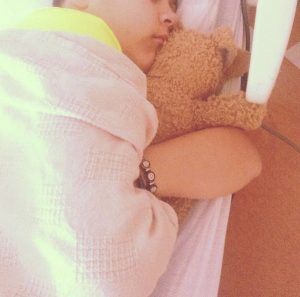
My younger brother, JJ, is a childhood cancer survivor. He was diagnosed with acute lymphoblastic leukemia a few days after friends and family celebrated his twelfth birthday. The moment we found out is one that I will remember unfortunately for the rest of my life. It was a hot, summer day in the middle of July. This is the typical weather in Brownsville, Texas, where it is hot 10 out of the 12 months of the year. As the time to when we received the phone call, it began to get gloomier. The sun hid behind the gray clouds and the wind slightly picked up and it seemed that the weather fit the occasion for the news we were about to get that day. About a month before he was diagnosed with cancer, my mom had taken my brother to his pediatrician because she had noticed that the lymph nodes under his armpit and on his neck were swollen that caused him some pain. He had gone to my mom stating that the “balls under his skin” caused him discomfort and when they were pressed on, resulted in him wincing in pain. A week later, my parents, brothers, and myself found ourselves sitting impatiently in the waiting at the Vannie E. Cook Jr. Children’s Cancer and Hematology Clinic located in McAllen, Texas, which was about an hour away from our home. Not liking how the swelling looked, the oncologist of the clinic sent us three days later to The Children’s Center at Renaissance where a biopsy was performed on him to get more accurate results of what the swelling could be. In just those few days, we felt the toll of having to wake up extremely early to make it on time to these appointments. We could only imagine how tiring it would be if the results were not what we wanted them to be. The weeks passed and the most heartbreaking day arrived.
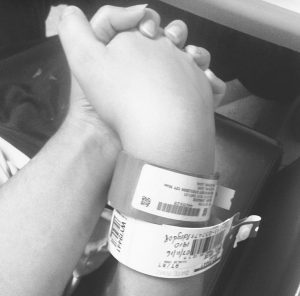
We had felt confident about the results, but we are firm believers till this day that God gives his toughest battles to his strongest warriors and that is who my brother is. Both my brothers were in their room playing on our Xbox 360 when my mom received the phone call. We found something. We found something. We found something. Those three words kept repeating themselves in my mind. The oncologist had been the one to personally call and said they had found something. It took about 20 minutes for my Dad and I to drive away from our house to my grandparents, where I collapsed in tears into the arms of my grandmother, who is also a cancer survivor. This was going to be our new life. It would now involve multiple hospital trips, extra precautions and nights with little to no sleep. Those nights of little to no sleep became nights of doing research, where I discovered information that I did not know before.
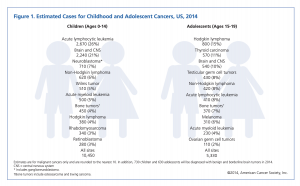
Childhood cancer is the second leading cause of death in children, despite the current advances in treatments. During my brother’s years of treatments, we came to know many children who unfortunately did not defeat this horrible disease. Though I did not interact with many of them, my parents met them along with their parents during some hospital stays. It was always heartbreaking to hear of a child that we knew pass away. It was even harder when they were younger than my brother and had a whole life ahead of them. For many of these young victims, their type of childhood cancer was rare and harsher. My brother was diagnosed with acute lymphoblastic leukemia (ALL), one of the most common types of childhood cancer. This type of cancer is so common it makes up about 26% of all cancers found in children between the ages of birth and 14 years old. followed by brain and central nervous system cancer, neuroblastoma and non-Hodgkin lymphoma according to a report made in 2014 by the American Cancer Society. 1

For three and a half years, my family and I endured early mornings and late nights at a hospital that was an hour from the comfort of our home. During the summer, my other younger brother and I tagged along with our parents and JJ to his chemotherapy treatments either at the clinic or the hospital. Expenses started to pile up, since for a few weeks, we had to do daily visits to McAllen. Fortunately enough, my mom has some amazing friends who did a hamburger fundraiser that was even more successful than we had expected. The fundraiser began at 10 in the morning and concluded at 6 PM that day. It got the point that they needed to go and purchase more hamburger items to sell because so many people came to support. At the end of the day, my mom’s friends raised about $4,000 for any expenses that my family and I would have. When school started back up, it was torture. We had gotten so used to being there for our little brother that it was tough for my brother, Francisco “Paco”, and I, to fully concentrate in school knowing that JJ was getting treatment an hour away. A few times, I would be the one that would cook for Paco and I whenever I would get home from school, while we waited for one of our parents to arrive. On many occasions, we would arrive home to my mom cooking, while JJ was getting homeschooled by a 7th grade teacher so he would not stay behind a year due to his treatment. We always looked forward to the weekends that we would be together, even if it meant that we would stay at the hospital. My dad or mom, depended who stayed with us, would pack some snacks, our inflatable mattress, blankets and pillows, so we would be as comfortable as we could during our stay. Typically, my dad would sleep on the not so comfy couch next to JJ, while my mom, Paco, and I would squeeze onto the inflatable mattress. The battle that felt would stop came to an end as I was a sophomore in college.
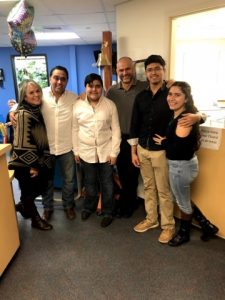
On November 2019, we found ourselves at the Vannie E. Cook Jr. Children’s Cancer and Hematology Clinic again, but this time for an exciting event. The day when JJ rings his bell that declares him cancer free is finally here. Surrounded by family and friends, he loudly and proudly rings his bell. So what follows now? Of course, he continues with check-ups though not as often as before. He continues to attend public school where he is a part of the chorale and prepares to attend St. Mary’s University in Fall 2022. I continue to pray for his health and think of what I can do next or even in the following years. I can’t forget the challenges we faced, knowing that many families continue to care for a child battling cancer. This is why starting a nonprofit organization to provide that support comes to mind. Though it is a long-term goal, it is one that has high priority in my list. I want to create a nonprofit organization very similar to one that helped my family and I when JJ was going through treatments called SuperRami & Friends, Inc. This nonprofit organization provides support for families who have a child battling cancer, as well as entertainment for the children receiving treatment at the hospital.
Starting a nonprofit organization is a complicated proposition, and I am thankful for all the mentors I have to help me get started. One of the founders of SuperRami & Friends, Inc. shared some brief information on their journey and the steps I need to take to get started. I expanded my network by contacting the former Alumni Relations chair, Dandy Pilon, of my middle school, Guadalupe Regional Middle School, who entered me in a Facebook group filled with different founders of successful nonprofit startups. One of the biggest goals I have for this nonprofit is to create two different university scholarships: one for childhood cancer survivors living in the Texas Rio Grande Valley and one for students who have a sibling battling or who has battled childhood cancer in the Texas Rio Grande Valley. To get an idea of how to go about this, I contacted Daniel Villanueva, a St. Mary’s University alumnus who created a scholarship for students who have a kidney disease or is a child of someone battling a kidney disease, in honor of his mother, Maria Villanueva, through the Texas Kidney Foundation.
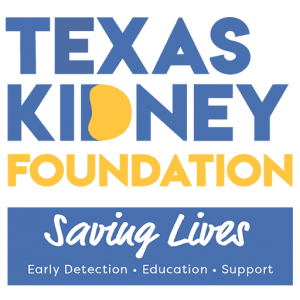
Villanueva’s mother lost her kidney function in the early 90’s and did not receive a kidney transplant until 1999, so she spent most of that decade on the transplant list. It was a year after Maria Villanueva’s passing in 2011 that Villanueva and his father sat down and decided to raise money for the only kidney foundation in San Antonio. That was when he was introduced to Marilyn Garcia, who had just started the State of Texas Kidney Foundation, later renamed the Texas Kidney Foundation. The goal of this organization was to help people living in San Antonio with kidney health awareness, screenings, kidney disease prevention and so much more. After several meetings between Garcia, Villanueva and his father, they got to action. “One day, I informed a lot of friends, family, and co-workers to come out and play some early afternoon miniature golf at a place called Cool Crest, a place my mom and dad took me when I was little,” said Villanueva. In just about an hour, they had raised a little under $2,000 and they were able to donate that money to the foundation.
A few months after the event, Villanueva, his wife, and father discussed starting a scholarship in his mother’s name. This scholarship, Villanueva said would, “…help people going to college who had a kidney disease themselves, donated a kidney, or were the son or daughter of a parent who suffered a kidney disease.” Garcia and the State of Texas Kidney Foundation mentioned to Villanueva that the money that had already been raised could be used to start the scholarship fund. The foundation would move the money that had been raised into a special dedicated account and every year, during a fundraiser, the Villanueva family would draw from that account to award scholarships. “The idea of starting it [the scholarships] was to help students who were in my same situation, wanting to go to school but needed help because of the medical expenses were so grand and made attending school difficult,” said Villanueva as to the reason why they decided to start those scholarships. Education was always the priority for Villanueva’s parents, and even with scholarships, Villanueva had to do work-study and work a second job while he attended college. After that first miniature golf fundraiser, the Villanueva family has held yearly fundraisers in the summer at the Alamo Drafthouse. The entry fee money collected from the attendees is donated to the create the scholarships yearly, and the attendees are able to learn more about kidney disease, watch a movie and have the chance to win door prizes. It is truly amazing what the Villanueva family has done to help college students and I plan to be able to the same some day. I know that this will not be easy and there will be several bumps down the road, but I know it’s feasible thanks to the Daniel’s example. SuperRami & Friends, Inc. co-founder, Cristy Maldonado walked me through the steps to get started.
Just figuring out a starting point, has been a challenge, but the resources that Maldonado shared with me defined the rules for non-profits and included information about the specific government forms that must be completed. According to Maldonado, one of the harder parts is making the nonprofit organization tax-deductible once it is approved. That is one of many problems I can encounter as an upcoming nonprofit creator. A study completed in February 2019 examined some problems that nonprofit creators encountered when starting up their organization. The author, Frederik O. Andersson discussed what problems seventy-seven upcoming nonprofit creators battled with when starting their new nonprofit. According to this study, there are three problems that growing nonprofit entrepreneurs typically encounter: getting resources to start, completing the work of the organization, and lastly, creating and maintaining strong relationships with others to help them keep the organization afloat.
Another specific study from a free workshop to start-up a nonprofit provided by the Midwest Center for Nonprofit Leadership completed between early 2013 and late 2015, evaluated of how well those entrepreneurs with their organizational development in 2016. Participants were asked to identify problems encountered in six categories. Those categories were financial, information, time-related, organizational, regulatory, and problems in the market. Of the seventy-seven responses from non-profit founders the Midwest Center staff received, all had run into at least one type of problem when starting their organization. The biggest issue these organizations had starting up were financial problems, followed pretty closely by organizational and information problems. One of the smallest issues was the market problems, which I believe how important communications is to the successful creation of a nonprofit. Seventeen of the participants never created their non-profit within the time limit of the study.2.
Social networking is crucial for nonprofit organizations, especially in today’s society when everything detail of every activity is posted on social media. There is no shortage of publications that support this. Scott Stevenson wrote a guide for non-profit social media use, and suggested that organizations follow one of four strategies for Facebook when launching a Facebook page for the organization. The four points include: update the status of the organization quite frequently, encourage friend interactions on the page, ensure that the friends who follow the page are people interested in your organization, and know how to address any sensitive or difficult topics. 3 As someone who has helped manage social media pages for many years, even as far back as working on the Facebook page for my middle school creating events or attracting audiences to events, these points are spot on. Although the social media platform now used by younger alumni is Instagram, Stevenson mentioned that Facebook can be used to reach younger alumni as well. I can also vouch for this, since that is how my middle school staff communicates the most with their alumni. Since we follow a page, where we can share and communicate with each other quite easily. As a communications intern with a non profit, I I learned first hand how important having a presence in social media is. While at the Maestro Entrepreneur Center we used a social media calendar to promote events, information, grants, and all other activities to track posting to all their social media sites. This drew audiences to the organization, which helped further promote the Center. Another nonprofit organization that I worked with, cdcb | come dream. come build. used their Facebook pages to let the housing communities learn about any events or activities that would be hosted monthly. I was responsible for creating most of the content that would go on their social media platforms, so it was really important that what I created was eye-catching and presentable for the audiences. The results are easily trackable and this helped hold me accountable for creating messages that would draw a crowd. This showcases why social media is important and contributes to the success of a non-profit.
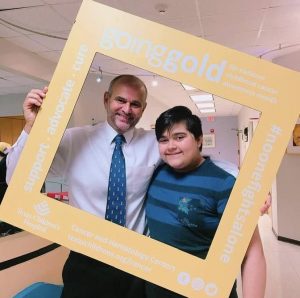
Creating a nonprofit organization will have its ups and downs. It is of course, not an easy journey since it requires a lot of thinking, preparation, and research. The need to support children impacted by cancer and their families is an important part of managing a difficult treatment process. It’s even more challenging for surviving children to financially transition into college, as well as their siblings and other immediate family members. For this reason, it is a long-term goal of mine to create this nonprofit for scholarship childhood cancer families and survivors. Continuing to learn from others, and following the process outlined while managing the concerns that generally prevent the success of nonprofits, has given be a great starting point. If you know someone that has been impacted by childhood cancer, keep a lookout on social media for different non-profit organizations that might be able to help them. In the near future, I hope to announce the startup of my own non-profit organization to help anyone who has been impacted by childhood cancer in various ways.
- “Cancer Facts & Figures 2014, Special Section: Cancer in Children & Adolescents.” American Cancer Society, 2014. https://www.acco.org/wp-content/uploads/2014/11/ACS-Special-Report-2014.pdf. ↵
- Andersson, Fredrik O. “The Bumpy Road of Nonprofit Creation: An Examination of Start-Up Problems Encountered by Nonprofit Entrepreneurs.” Nonprofit & Voluntary Sector Quarterly 48, no. 1 (February 2019): 194–207. https://journals.sagepub.com/doi/pdf/10.1177/0899764018785464. ↵
- Stevenson, Scott C. 2011. Social Media and Communications Technology : Essential Strategies for Nonprofits and Associations. Stevenson, Inc.: 4-9. https://onlinelibrary-wiley-com.blume.stmarytx.edu/doi/pdf/10.1002/9781118703946.ch1. ↵

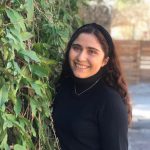
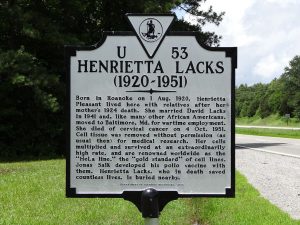
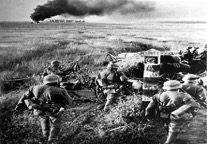
25 comments
Franchesca Tinacba
Hello Eva! I absolutely loved your article, and it was written so well. I never was fully aware about how little childhood cancer was brought up. I believe this article will definitely shed some light on the importance of childhood cancer. Stories like your brother’s motivate me more and more to help children in the medical field (which is the path I am currently going down in college). Thank you so much for sharing this story.
Kensley Dieckow
Wow! congratulations on this inspiring award winning article. I work very closely with the Leukemia and Lymphoma society here in San Antonio and I really appreciate you being so vulnerable and strong to share your brothers story. Articles like these just show to so many people that even if you are not personally affected by cancer or someone you know that its so important to try to raise awareness and help in anyway we can. Your brother is truly a warrior.
Christian Guerrero
Hello,
Congratulations on your nomination! It is amazing to see how children’s cancer is underrepresented and other cancers are what is talked about like breast cancer, lung cancer, etc. I know that St. Jude’s is one that specifically deals with children’s cancer but it would be interesting to conduct a survey on why people overlook cancer in children? Is it because little to no advertising or could it be that people focus on cancer that can potentially affect themselves.
Madeline Chandler
This was an extremely well-written article, and it was so detailed. It was so interesting because I had very little previous knowledge of the rates of childhood cancer diagnosed. It is so unfortunate that more people do not know about this, and people have created campaigns to spread information and raise awareness. It is so thoughtful and meaningful that you would share your personal family story with the battle with childhood cancer. Thank you so much for sharing and your goals to raise awareness.
Natalia Ramirez
This was a great inspiring article! Also, congratulations on your nomination! Best of luck! This was such a beautiful personal story, and I’m glad you shared it with all of us. You are very brave for that. Thank you for brining childhood cancer awareness. I hope your brother knows he is a true fighter and such an inspiration to many.
Cassidy Colotla
Eva, what a beautiful and well executed article. It’s so inspiring to hear kids stories and I’m glad that you put resources out there like donating to a nonprofit to help. I’m sad to admit that like you suggested I was one of the many who was clueless about facts on childhood cancer, but this article has made me want to learn more and do more. God bless your family and JJ. Thank you for sharing not only your brothers story but your experience dealing it as well.
Jesslyn Schumann
Hi Eva, thank you for sharing such a personal and beautiful story. I know it probably was not easy to write about, but it brought awareness to not only childhood cancer, but how foundations can help those who are struggling. Though I knew that non-profits could help, I did not realize that it could help as much as it does. Once again, thank you so much for sharing and good luck at the award ceremony!
Kalyssa Zamora
Hi Eva,
Your article was truly beautifully written. I thank you for sharing your little brother’s story and for advocating for those with similar stories to his. It is saddening to hear that the statistic is that high for those of such young ages and not being made much aware. You writing this article is a step toward bringing awareness and then alongside that, trying to create a nonprofit yourself, is an even much bigger and more beautiful step.
Stephanie Flores
Hey Eva,
Thank you for sharing this beautifully written article with us. A particular statistic you pointed out is 1 in every 285 children get diagnosed with childhood cancer. Being such a large statistic I’m surprised there is not more awareness about it. Being able to learn a little about you brother (JJ) battle with cancer and how it also affected your entire family just proved even more why this should be talked about more. I think it is so beautiful that because of the people who helped you all through this journey, you, yourself are planning to create a nonprofit to assist those who are in similar situations. Congratulations on your nomination and best of luck on your future endeavors including the nonprofit.
Paula Ferradas Hiraoka
Hello Eva,
First of all, congratulations on your nomination and getting your article published!
What an incredible and inspiring article! Talking about cancer is not easy, so I’m really proud that someone got inspired to make an article about this. I understand your feeling when you hear someone that is important for you got cancer. I also liked that you made awareness to non-profit organizations.
Overall, this article is very impactful and educational. Thank you for being and provide awareness of childhood cancer, being open in this article, and good luck!